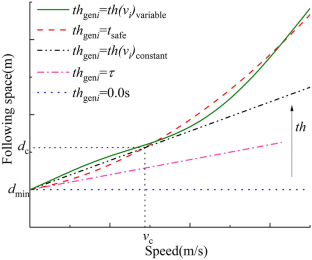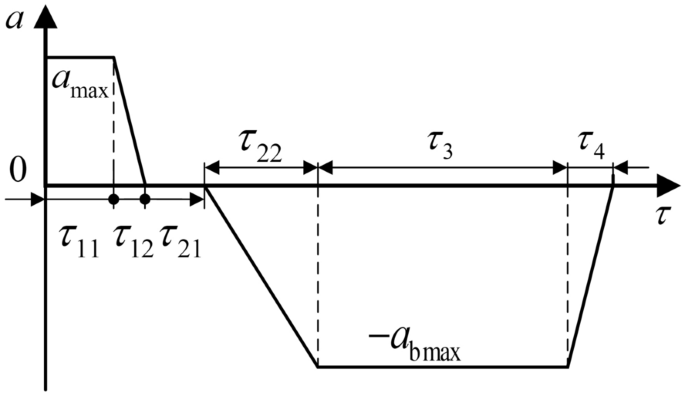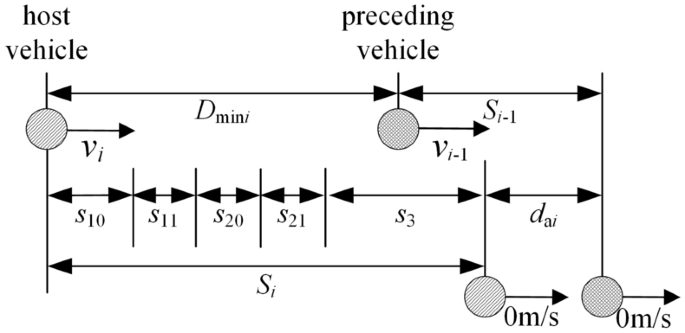Abstract
Cooperative adaptive cruise control (CACC) is acknowledged as an efficient solution to relieve traffic congestion while ensuring traffic safety. This paper aims to improve traffic efficiency via both the effective following spacing policy and the CACC with platoon kinematics. Firstly, the correlation mechanism of safety spacing policy and time headway policy is analyzed, a versatile generic spacing model is established, and an efficient spacing policy is proposed by leveraging the concept of safety redundancy. Secondly, based on the “virtual centroid” of the platoon, the CACC upper control strategy with platoon kinematics is proposed to improve traffic efficiency. The strategy is complemented by the design of a sliding mode controller, which precisely allocates longitudinal acceleration. Additionally, a lower controller is developed to track the desired acceleration accurately and rapidly under various driving and braking conditions. Thirdly, eight typical scenarios for urban traffic are reconstructed via three-layer decompositions, and the index named synchronization is proposed to evaluate the performance of CACC with platoon kinematics. Finally, a simulation test is conducted, demonstrating that the proposed CACC strategy synchronously responds to the kinematics of the preceding platoon, reducing the accumulation of response delay, ensuring both vehicle following safety and efficiency.






Similar content being viewed by others
References
Levine, W.S., Athans, M.: On the optimal error regulation of a string of moving vehicles. IEEE Trans. Automat. Contr. 11(3), 355–361 (1966)
Xiao, L., Gao, F.: A comprehensive review of the development of adaptive cruise control systems. Veh. Syst. Dyn. 48(10), 1167–1192 (2010)
Van Arem, B., Van Driel, C.J.G.: The impact of cooperative adaptive cruise control on traffic-flow characteristics. IEEE Trans. Intell. Transp. Syst. 7(4), 429–436 (2006)
Montanaro, U., Dixit, S., Fallah, S., et al.: Towards connected autonomous driving: review of use-cases. Veh. Syst. Dyn. 57(6), 779–814 (2019)
Amoozadeh, M., Deng, H., Chuah, C.N., et al.: Platoon management with cooperative adaptive cruise control enabled by VANET. Veh. Commun. 2(2), 110–123 (2015)
Rajamani, R., Tan, H.S., Law, B.K., et al.: Demonstration of integrated longitudinal and lateral control for the operation of automated vehicles in platoons. IEEE Trans. Control Syst. Technol. 8(4), 695–708 (2000)
Madeleine, E.L.Z., Dafflon, B., Gechter, F., et al.: Vehicle platoon control with multi-configuration ability. Procedia Comput. Sci. 9, 1503–1512 (2012)
Zhang X, Li W, Guo K, et al.: Longitudinal acceleration allocation for cooperative adaptive cruise control including platoon kinematics. In: 2019 IEEE 28th International Symposium on Industrial Electronics (ISIE), pp. 1512-1517. Vancouver (2019)
Shladover, S.E.: Longitudinal control of automotive vehicles in close-formation platoons. J. Dyn. Syst. Meas. Control. 113, 231–241 (1991)
Marsden, G., McDonald, M., Brackstone, M.: Towards an understanding of adaptive cruise control. Transp. Res. Part C Emerg. Technol. 9(1), 33–51 (2001)
Ploeg J, van de Wouw N, Nijmeijer H.: Fault tolerance of cooperative vehicle platoons subject to communication delay. In: Proceedings of the 12th IFAC Workshop on Time Delay Systems (TDS 2015), Ann Arbor, MI, United States, 28–30 Jun 2015, pp. 352–357 (2015)
Yanakiev, D., Kanellakopoulos, I.: Nonlinear spacing policies for automated heavy-duty vehicles. IEEE Trans. Veh. Technol. 47(4), 1365–1377 (1998)
Zhang, X., Huang, Y., Guo, K., et al.: Integrated spacing policy considering micro-and macroscopic characteristics. Automot. Innov. 2(2), 102–109 (2019)
Tongue, B.H., Packard, A.K., Sachi, P.: An approach to determining worst case platoon behavior. Veh. Syst. Dyn. 28(6), 357–383 (1997)
Yang, H., Rakha, H., Ala, M.V.: Eco-cooperative adaptive cruise control at signalized intersections considering queue effects. IEEE Trans. Intell. Transp. Syst. 18(6), 1575–1585 (2016)
Li, Y., Wang, H., Wang, W., et al.: Evaluation of the impacts of cooperative adaptive cruise control on reducing rear-end collision risks on freeways. Accid. Anal. Prev. 98, 87–95 (2017)
International Organization for Standardization: ISO 20035:2019 - Intelligent transport systems Cooperative adaptive cruise control systems (CACC) Performance requirements and test procedures (2019)
Xiao, L., Gao, F.: Practical string stability of platoon of adaptive cruise control vehicles. IEEE Trans. Intell. Transp. Syst. 12(4), 1184–1194 (2011)
Zhou, J., Peng, H.: String stability conditions of adaptive cruise control algorithms. IFAC Proc. Vol. 37(22), 649–654 (2004)
Acknowledgements
Special thanks are due to the National Natural Science Foundation of China (52072144, 52122216, 51675217), and the Opening Founding of State Key Laboratory of Automotive Simulation and Control (20201101) for supporting authors' research.
Author information
Authors and Affiliations
Corresponding author
Ethics declarations
Conflict of interest
On behalf of all the authors, the corresponding author states that there is no conflict of interest.
Appendices
Appendix A
The detailed derivation of Eq. (1):
In the extreme manual braking case, the host vehicle travels at constant acceleration \({a}_{{\text{max}}}\), and its preceding vehicle travels at constant deceleration \({a}_{{\text{bmax}}}\), the braking process can be described by Figs. A1 and A2.
\({\tau }_{11}\) is the time required to detect that the preceding vehicle starts to brake, \({\tau }_{12}\) is the time for the driver to release the accelerator pedal completely; \({\tau }_{21}\) is the time to move the foot to the braking pedal and eliminate the mechanical clearance of the braking system, \({\tau }_{22}\) is the time to increase braking force, \({\tau }_{3}\) is the continuous braking time, and \({\tau }_{4}\) is the braking release time.
During the period of \({\tau }_{11}\), the host vehicle travels at a uniform acceleration, so the distance and velocity is derived as:
During the period of \({\tau }_{12}\), it is assumed that the acceleration decreases linearly, so the velocity and distance are calculated through integration:
During the period of \({\tau }_{21}\), the vehicle travels at constant speed \({v}_{2}\):
During the period of \({\tau }_{22}\), it is assumed the deceleration increases linearly, the velocity and distance are calculated through integration:
During the period of \({\tau }_{3}\), the host vehicle travels at a uniform deceleration, so the distance and velocity is derived as:
Above all, the braking distance of the host vehicle is:
Since the preceding vehicle travels at a uniform deceleration, the braking distance is derived as:
To guarantee the safety, the distance that the host vehicle should maintain from the preceding vehicle is:
where \({d}_{ai}\) is a safety margin.
Appendix B: Description of parameters
- \({a}_{{\text{bmax}}}\):
-
Maximum deceleration \(({\text{m}}/{{\text{s}}^{2}})\)
- \({a}_{{\text{max}}}\):
-
Maximum acceleration \(({\text{m}}/{{\text{s}}^{2}})\)
- \({\tau }_{11}\):
-
Time to detect that the preceding vehicle starts to brake (\({\text{s}}\))
- \({\tau }_{12}\):
-
Time for driver to release the accelerator pedal completely (\({\text{s}}\))
- \({\tau }_{21}\):
-
Time to move the foot to the braking pedal and eliminate the mechanical clearance (\({\text{s}}\))
- \({\tau }_{22}\):
-
Time to increase braking force (\({\text{s}}\))
- \({\tau }_{3}\):
-
Continuous braking time \(({\text{s}})\)
- \({\tau }_{4}\):
-
Braking force release time (\({\text{s}}\))
- \({d}_{{\text{min}}}\):
-
Centroid distance between the host vehicle and preceding vehicle when their velocities are 0 \(({\text{m}})\)
- \(th\):
-
Constant time headway \(({\text{s}})\)
- \({v}_{i}\):
-
Velocity of the \(i\)th vehicle (\({\text{m}}/{\text{s}}\))
- \({d}_{{\text{emei}}}\):
-
Safe distance of the emergency braking case \(({\text{m}})\)
- \({d}_{{\text{stei}}}\):
-
Safe distance of the steady following case \(({\text{m}})\)
- \({d}_{{\text{saf}}i}\):
-
Safe distance of the safety spacing policy \(({\text{m}})\)
- \({{th}}_{{\text{gen}}i}\):
-
Time headway of the generic spacing model (\({\text{s}}\))
- \(th({v}_{i})\):
-
Time headway on \({v}_{i}\) (\({\text{s}}\))
- \({t}_{{\text{safe}}}\):
-
Time headway of the safety spacing policy \(({\text{s}})\)
- \({v}_{\text{c}}\):
-
Critical velocity (\({\text{m}}/{\text{s}}\))
- \({d}_{{\text{ef}}i}\):
-
Distance from the \(i\)th vehicle to its preceding vehicle of the efficient spacing policy \(({\text{m}})\)
- \({d}_{i}\):
-
Centroid distance between the \(i\)th vehicle and its preceding vehicle (\(({\text{m}})\))
- \({e}_{i}\):
-
Centroid distance tracking error of the \(i\)th vehicle (\({\text{m}}\))
- \({d}_{{\text{G}}}\):
-
Distance of the virtual centroid (\({\text{m}}\))
- \({v}_{{\text{G}}}\):
-
Velocity of the virtual centroid (\({\text{m}}/{\text{s}}\))
- \({a}_{{\text{G}}}\):
-
Acceleration of the virtual centroid (\({\text{m}}/{{\text{s}}}^{2}\))
- \({d}_{{\text{des}}i}\):
-
Desired centroid distance between the \(i\)th vehicle and following target \(({\text{m}})\)
- \({a}_{{\text{des}}i}\):
-
Desired acceleration of the \(i\)th vehicle \(({\text{m}}/{{\text{s}}^{2}})\)
- \(\lambda\):
-
Sliding surface convergence speed
- \(c\):
-
Sliding surface parameter
- \({\widehat{\tau }}_{s}\):
-
Estimation of the vehicle response time
- \({W}_{i}\):
-
Weight of \(i\)th vehicle in the platoon
- \({u}_{{\text{throttle}}}\):
-
Throttle opening
- \({u}_{{\text{b}}}\):
-
Brake master cylinder pressure
- \({I}_{{\text{s}}}\):
-
CACC Synchronic index \(({\text{s}})\)
- \({\tau }_{s}\):
-
Vehicle response time (\({\text{s}}\))
- \(\tau\):
-
Braking response time (\({\text{s}}\))
- \({a}_{i,{\text{des}}}\):
-
Desired acceleration of the \(i\)th vehicle for ACC (\({\text{m}}/{{\text{s}}}^{2}\))
Rights and permissions
Springer Nature or its licensor (e.g. a society or other partner) holds exclusive rights to this article under a publishing agreement with the author(s) or other rightsholder(s); author self-archiving of the accepted manuscript version of this article is solely governed by the terms of such publishing agreement and applicable law.
About this article
Cite this article
Zhang, X., Li, S., Guo, K. et al. Efficient Cooperative Adaptive Cruise Control Including Platoon Kinematics. Automot. Innov. (2024). https://doi.org/10.1007/s42154-023-00243-2
Received:
Accepted:
Published:
DOI: https://doi.org/10.1007/s42154-023-00243-2




